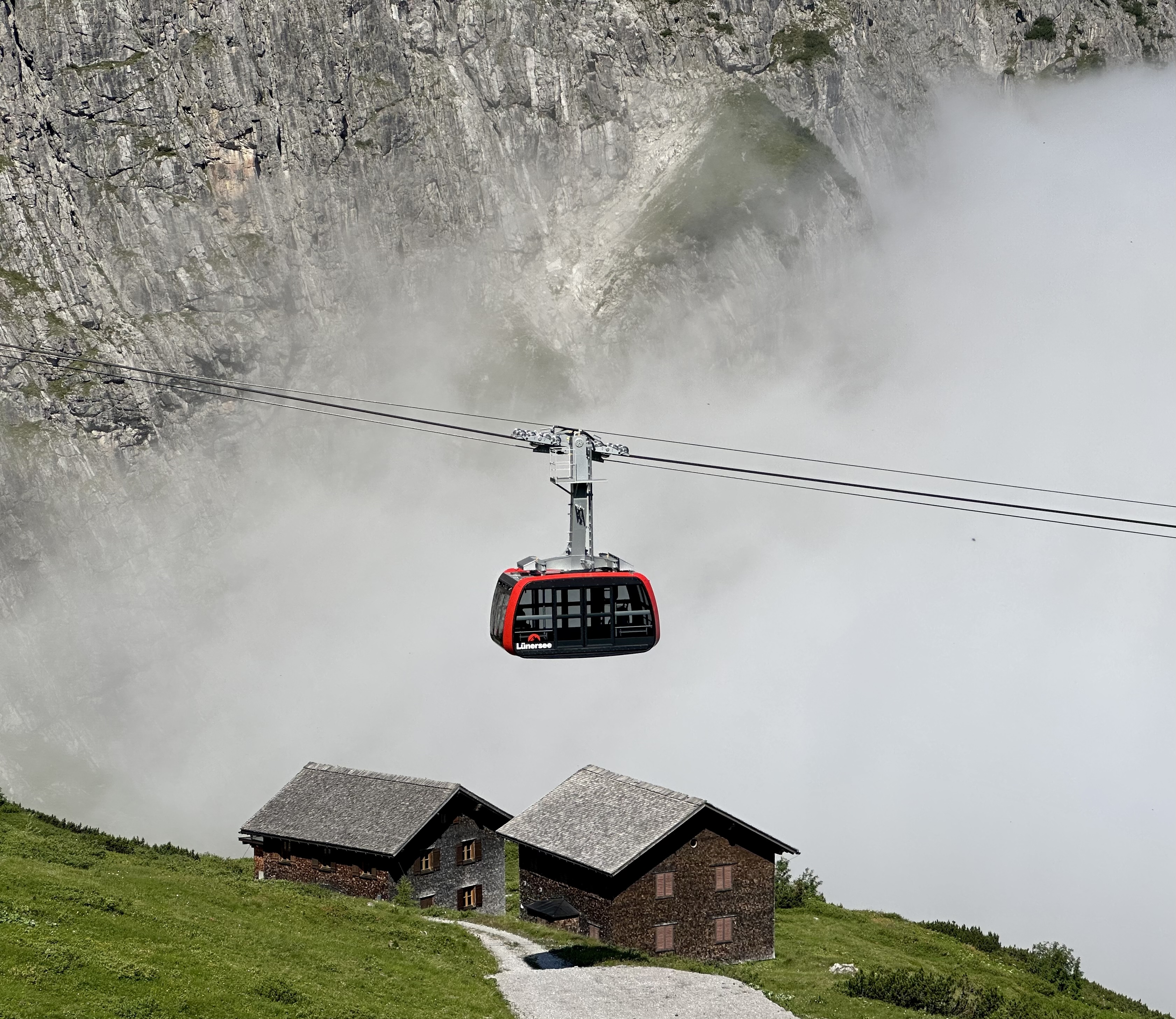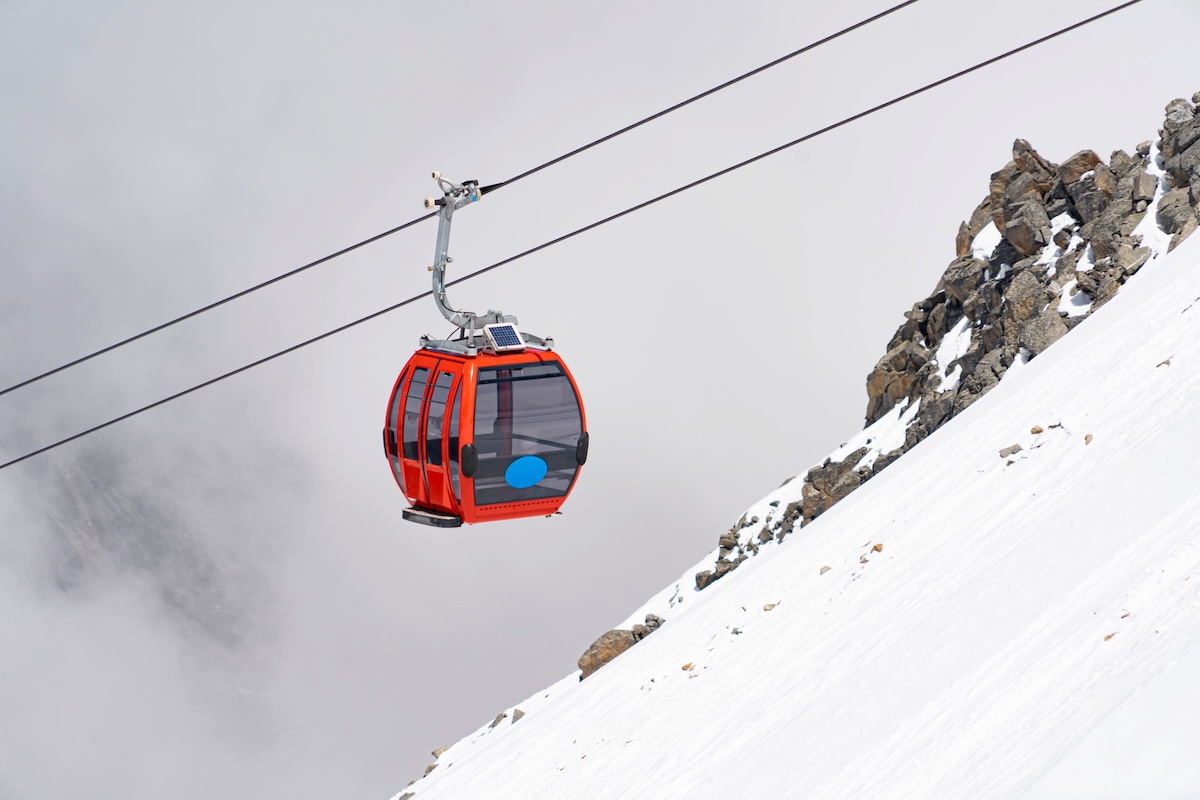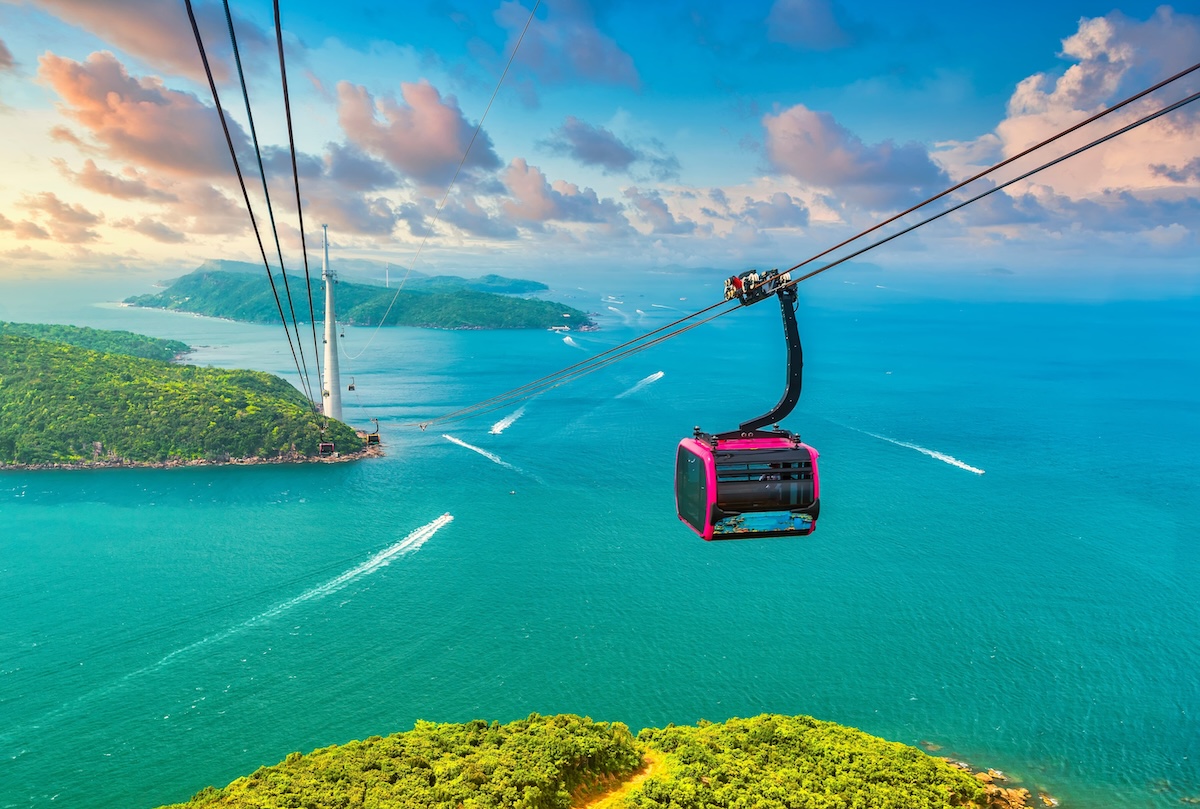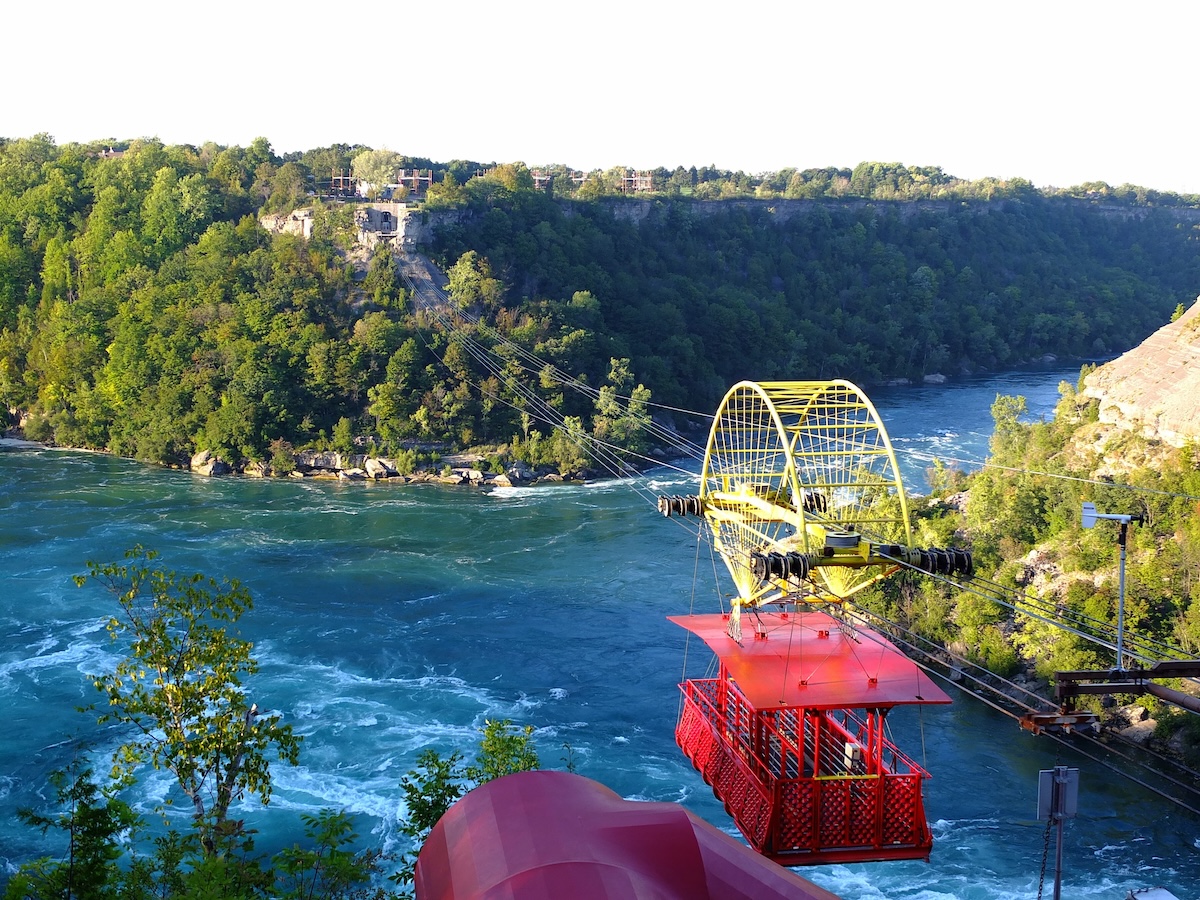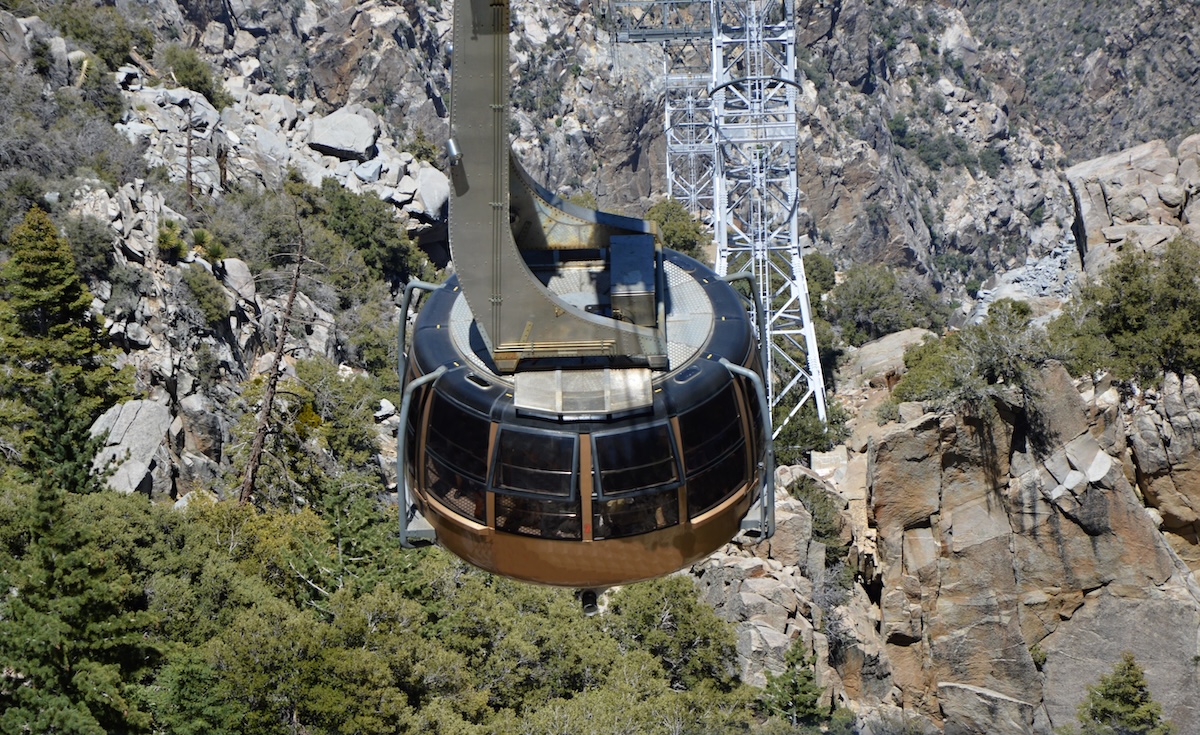A Treatise on the Planet’s FINEST Mountain Taxis
For all of humankind’s strengths and faults, we can say one thing for sure; we are industrious little beasts.
While it’s indisputable that all of this innovation has come at the cost of our planet’s environment and natural habitat, we have made progress. Modern medicine, shaped fat skis, and mountain bike geometry and componentry are just a few of the marvels straddling the line between technology and magic.
However, no feat of engineering figures more prominently (literally and figuratively) than the cable car. After summiting the Aiguille du Midi in 1818, how could the great Savoyard mountaineer Jaques Balmat have imagined there would be a cable car to the same peak just 137 years later?
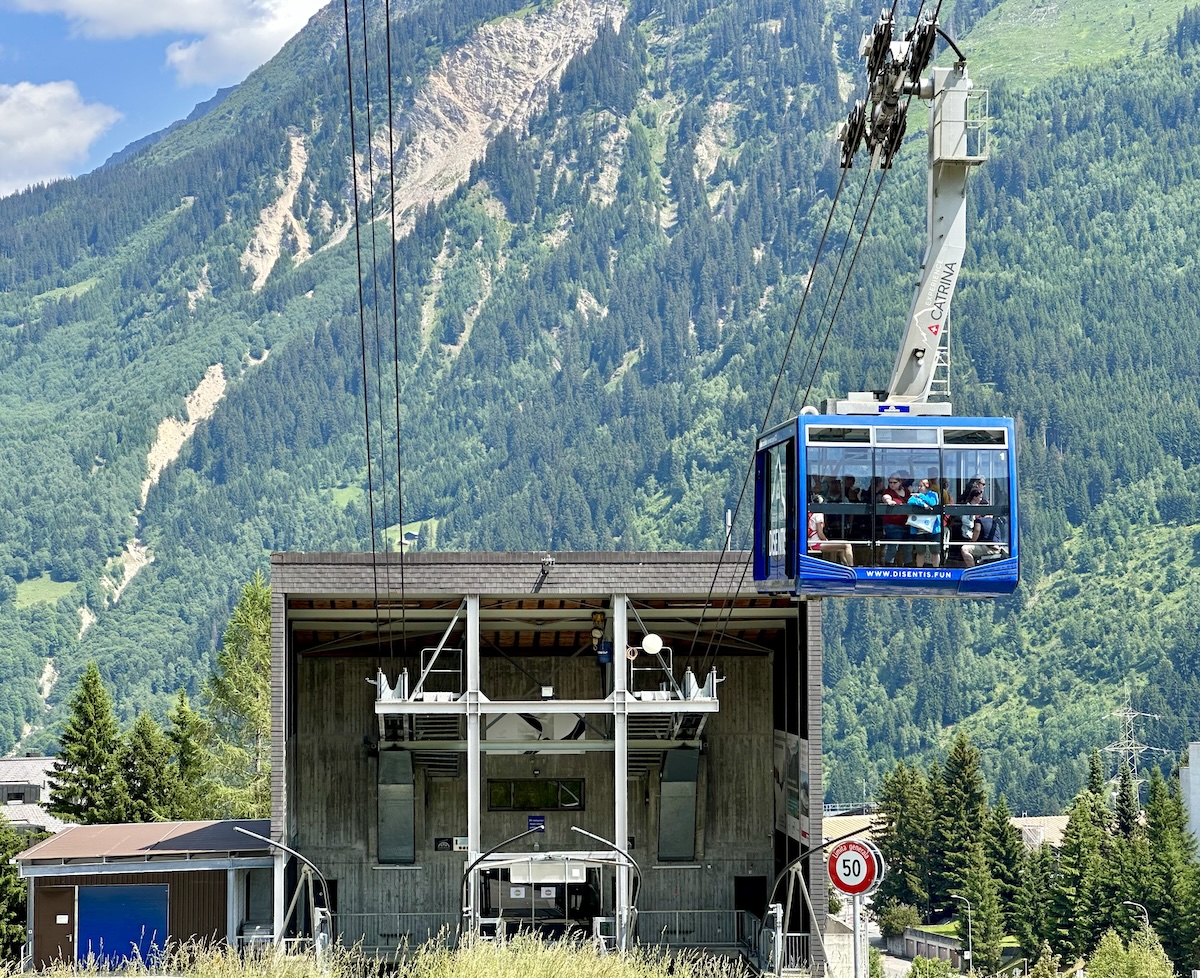
World Mountain Lifts
The best tool to track the thousands of cable cars scattered across our lovely planet? That would be World Mountain Lifts, a feature of the PeakVisor webpage.
Here, we track 12,797 lifts at 1,440 destinations around the world. We add new lifts daily, so that number will probably be higher by the time you read this. Many of these lifts have real-time updates. For example, if a lift shuts down due to lightning, we update it on the app.
A Brief History
The first cable cars came about in the late 19th century in San Francisco, USA, based on conveyance systems used in the mining industry. These early systems resembled miniature trains. However, rather than an engine, the mechanism of motion was actually an underground cable that pulled cars around the city on rail tracks.
Nevertheless, it wasn’t until the beginning of the 20th century that advances in engineering and human imagination gave birth to the mountain cable cars we know today.
Humans have engineered several types of cable cars over the years. The most common include gondolas, funiculars, funitels, and aerial trams (French: Téléphérique, German: Seilbahn).
In 2023, cable cars figure more prominently into our lives than ever globally. Thousands of specimens operate across every populated continent. Whereas the cable car began as a mode of commuter transportation, it dominated the 20th century as a vehicle for tourists, sightseers, and outdoor recreationists. However, with increasing urban congestion and pollution, the cable car is making a pronounced comeback as a commuter tool.
Cable cars are often touted in superlative terms to garner notoriety and stand out amongst their peers. People want to experience the longest, highest, fastest, steepest, etc. Without further ado, let’s dive into the world’s finest cable cars.
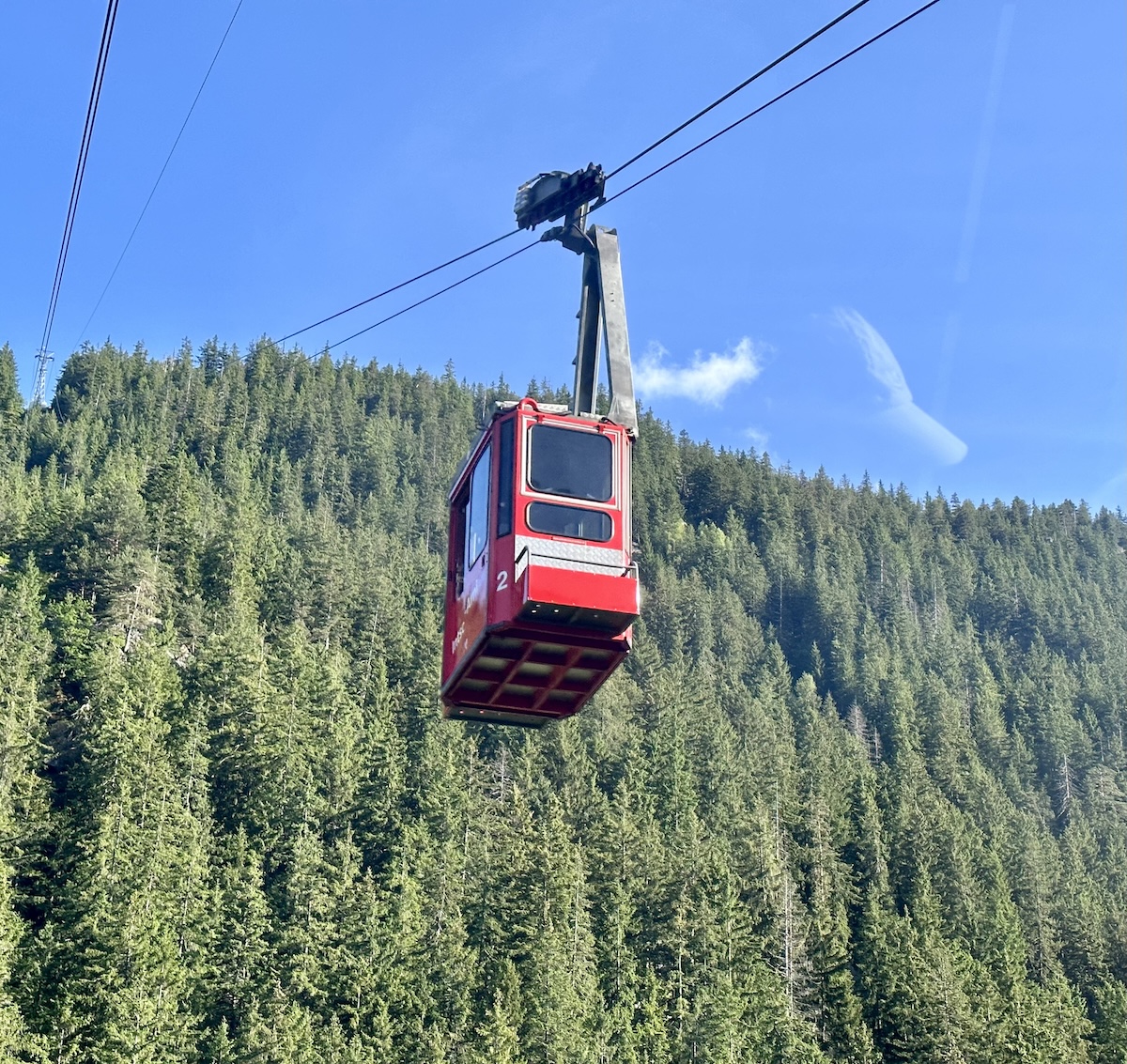
World’s Highest Cable Car
The Dagu Glacier Gondola is the world's highest cable car at 4,860 m (15,945 ft), according to a plaque at the top station. Other sources (including our website) list it at 4,813 m, but either way, it’s still the highest out there. The lift is in Aba Tibetan and Qiang autonomous prefecture in Sichuan, China, and is higher than Mont Blanc’s summit.
Intriguingly, despite its enormous elevation, the gondola is not exceptional from an engineering standpoint. It’s a standard Doppylmayer with ten pylons and 36 detachable gondola units. The lift ascends 1,250 meters (4000 ft), is about ten minutes long, and shuttles 800 people per hour at normal speed. Construction took almost two years, with numerous delays due to weather; the gondola opened on May 1st, 2008.
The views are, as one would expect, incredible. Mountains continue nearly uninterrupted until you reach central Asia, thousands of kilometers away.
As our honorary runner-up, Jade Dragon Snow Mountain Cable Car reaches 4506 meters (14,783 ft) above the beautiful town of Lijiang, China.
World’s Longest Cable Car
Tianmen Shan Gondola
The Tianmen Shan Gondola, also in China is the longest high-mountain cable car at 7.455 km (4.63 mi). Consequently, it takes almost half an hour to cover the distance, even at the brisk pace of 6 m/s (13.5 mph).
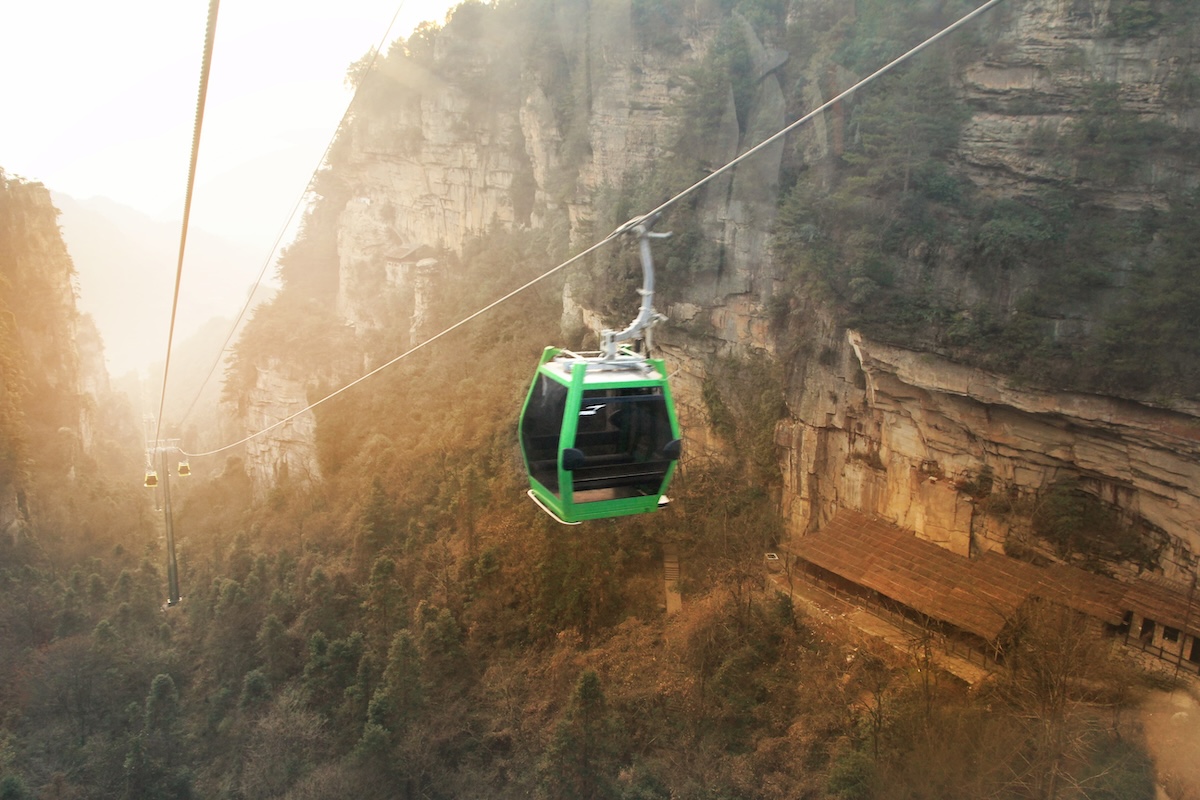
The cable car ascends from the town of Zhangjiajie to 1,279 m (4,196 ft) on Tianmen Mountain, offering excellent views of the natural arch known as “Heaven’s Door.”
The top station access kilometers of glass walkways built into towering cliffs; you can walk the 999 steps (the “Stairway to Heaven”) to the mountain’s summit.
La Paz - El Alto Commuter Gondola
Most people haven’t used or even heard of commuter cable cars. Despite their obscurity in the Western world, these efficient machines are integrated into congested urban centers worldwide. La Paz boasts the most extensive example.
La Paz and Alto are two of the largest cities in Bolivia. Before the completion of the cable car, known as Mi Teleférico, the route between the two was long, arduous, and constantly snarled with traffic. Beginning in 2014, the two cities linked via a 30.6 km (19.0 mi) cable-car system that functions like an above-ground metro. Mi Teleférico consists of over 30 stations and travels at an average speed of 11.2 mph (18.0 km/h).
Mi Teleférico now serves upwards of 300,000 passengers daily. However, I can’t speak for the system's overall efficiency: congestion, travel times, etc. There are ten lines, with an additional one in the works, but some parts of the city are still isolated from Mi Teleférico stations.
Hopefully, the project will serve as a beacon of clean transportation as urban centers worldwide become more polluted.
At the very least, riding a cable car through these mountainous metropolises is the most relaxing way to commute to work.
World’s Highest-Ascent Cable Car
The legendary Aiguille du Midi in Chamonix, France, is well-known as the world’s highest vertical-ascent cable car. While the ever-ambitious Chamonyards first envisioned the lift in 1909, they didn’t complete construction until 1955. It remains the premier mountain lift for nearly every genre of extreme sport, and the views aren’t half bad either.
The Midi cable car rises an astounding 2800 m (9200 ft) from the center of Chamonix to the top of the eponymous needle-like spire overlooking the town. The ascent takes 20 minutes. The mid-station offers excellent hiking access, while the top station has a restaurant and 360-degree views of the Mont Blanc Massif and its glaciers.
Don’t hesitate to pull the trigger on this one. You won’t find any mention of this on the internet, but word on the street is that the Midi lift will close in the next decade or two. Climate change is melting the permafrost ‘cement’ layer at a measurable rate, leading to a massive increase in rockfall across the Mont Blanc Massif and the French Alps.
Due to the melting, the top station of the Aiguille will likely collapse sometime in the next century, although authorities will have closed the lift long before that happens. But don’t worry; the structure is stable for now. In my opinion, considering everything the Aiguille offers, it’s the best cable car on the planet.
World’s Fastest Cable Car
It’s difficult to say for sure, but the Hon Thom Cable Car in Vietnam may well be the fastest on the planet. They claim to be the longest as well, but the Teleférico in La Paz is much longer, while the Dagu Glacier Gondola ascends a giant mountain. As a traverse across islands rather than an ascent up mountains, the Hon Thom just missed its chance to secure a spot.
However, they’ve made it onto the write-up after all. The official stats suggest that this beast carries an average speed of 8.5 m/s (19.2 mph), completing its 8 km (5 mi) route in about 15 minutes. The Hon Thom is an aerial tram-style cable car - these numbers would never be possible with a traditional gondola.
As an added bonus, the views of the tropical turquoise sea are simply stunning.
World’s Oldest Cable Car Still in Operation
The Whirlpool Aero Car transports 35 passengers at a time over the Niagara River in Niagara Falls, Canada. It is the oldest aerial cable car still in operation today.
Although the system has been updated three times (most recently in 1984), this adorable cable car is an antique and looks the part. The Spanish engineer Leonardo Torres Quevedo, who designed the cable car in 1916, incorporated many delicate and aesthetic flourishes. As with most things in our society, this artisanal approach has been lost in recent decades.
The Aero Car travels about 1 km (.6 mi) across the river at an average height of 60 m (200 ft) above the water’s surface. The cabin was once open-air, but subsequent upgrades incorporated a roof. The Niagara whirlpool churns and froths below. Although both stations are within Canadian territory, the cable car crosses the border with the U.S. approximately four times throughout the journey.
An honorable mention to the original cable cars of San Francisco, many of which still run, traversing the same routes as they have for hundreds of years. However, although the underlying technology evolved from these trolleys, we’re focused on Aerial Cable Cars.
World’s Steepest Cable Car
The Loen Skylift in Stryn, Norway, became the steepest cable car in the world upon its construction in 2017.
The new aerial tram ascends to the summit of Mount Hoven, offering breathtaking views above the Nordfjord. Although it only reaches a height of 1,008 meters (3,307 ft), it is the world's steepest cable car, with a maximum gradient of 60 degrees and an average gradient of 45 degrees. The Skylift reaches a top speed of 7 meters per second (15.7 mph) and obtains a height of 170 meters (560 ft) above the ground. It was the first aerial tramway installed in Norway since Hangursbanen in 1963.
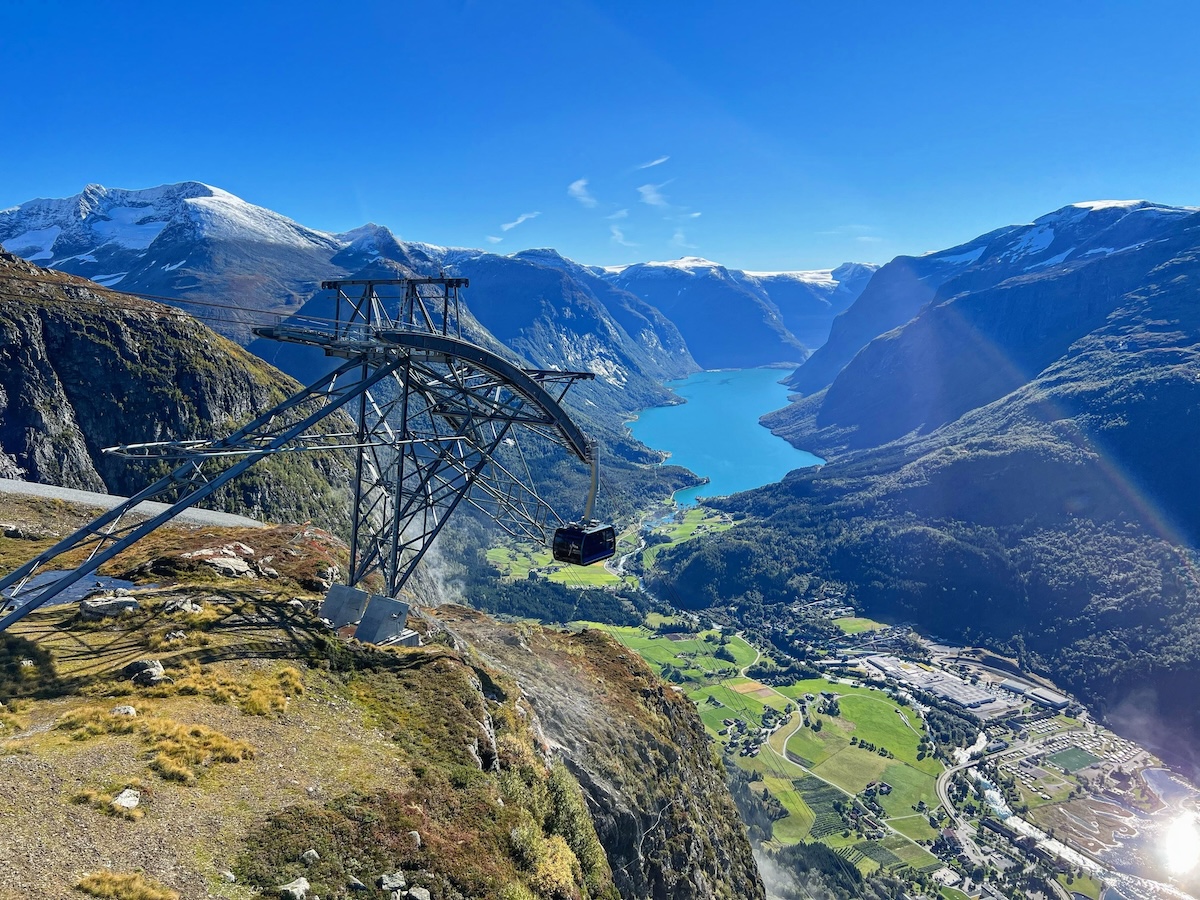
Rotating Cable Cars
What’s even better than a cable car? The answer is obviously a ROTATING cable car. Three of these marvels exist currently. Here’s the lowdown.
Titlis Rotair
The Titlis Rotair cable car ascends towards the eponymous ice-capped peak while offering a unique rotating experience. The Rotair ascends to a summit station at an impressive elevation of 3,020 meters above sea level.
During the approximately five-minute journey, the cable car completes a 360-degree rotation, providing enchanting panoramic vistas of cliffs, crevasses, and majestic snow-covered peaks. It also serves as the top lift for the Engelberg Ski Resort, which happens to be one of the world’s finest, particularly for advanced and expert skiers.
Palm Springs Aerial Tramway
The Palm Springs Aerial Tramway holds the highly specialized title of “world's largest rotating tram car.”
Palm Springs locals were inspired to build the tram in the mid-60s to escape the sinister desert heat. The tram ride spans over two-and-a-half miles along the cliffs of Chino Canyon. Its final destination is the unspoiled wilderness of Mt. San Jacinto State Park and Wilderness Area.
Throughout this ten-minute excursion, the tram cars slowly revolve while the ambient air temperature cools by an impressive gradient of 30 degrees Fahrenheit.
Skyway Monte Bianco
Like the Aiguille du Midi just across the ridge, the Skyway Monte Bianco transports tourists and extreme sports junkies to an elevation of 3,500 meters amidst Mont Blanc’s vast glaciers. The Skyway is in Courmayeur, Italy, on the south side of the Mont Blac Massif.
The journey begins at the Pontal-Courmayeur station (1,300 m/4,265 ft) and reaches 3,466 m (11,371 ft) at Punta Helbronner. Four panoramic semi-spherical cabins gently rotate 360 degrees throughout the ascent, showcasing the magnificence of Mont Blanc and the surrounding peaks, such as the Matterhorn, Monte Rosa, and the Gran Paradiso.
Construction on the Skyway Monte Bianco cable car began in April 2012 and was completed on May 29, 2015, at a cost of over 100 million euros.
Open-Air Cable Cars
What’s better than a rotating cable car? You guessed it: an open-air cable car. There is currently just one in the world, although I’m sure that will change over the next few years.
The CabriO, a double-decker, open-air cable car on Mount Stanserhorn, became the world’s first in 2012. Unlike traditional cable cars, it uses two side-mounted support cables, providing unobstructed panoramic views without pesky overhead cables obstructing your view.
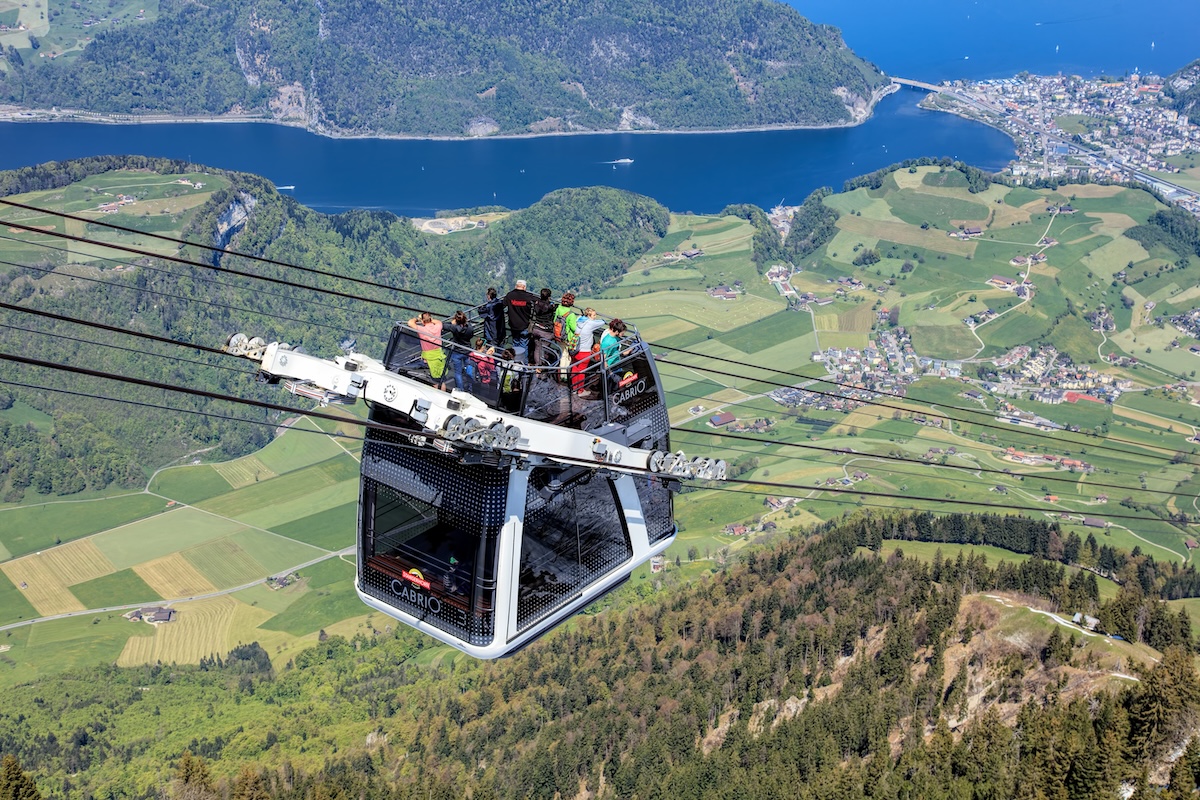
Capable of accommodating 60 passengers per ride, the CabriO features an elegant staircase leading to the spacious top deck, where 30 individuals can enjoy the open-air experience. The lower deck offers a more shielded perspective for those intimidated by the open-air exposure.
Hopefully, we have some engineers out there brainstorming the world’s first rotating, open-air combo cable car. I don’t know about you, but I won’t be truly satisfied until they cut the ribbon on one of those.
Southern Hemisphere Cable Cars
Queenstown Skyline Gondola
The magnificent Skyline Gondola is the steepest cable car lift in the Southern Hemisphere. Ascending 480 meters (1575 ft) above Queenstown, New Zealand, and the stunning Lake Wakatipu, the Gondola reaches the summit of Bob's Peak.
Bob’s Peak offers plenty of touristy attractions like views, a bar, a restaurant, and a luge track, but my gig of choice is the Skyline Bike Park, the Southern Hemisphere’s finest lift-access mountain riding.
Scenic Skyway Blue Mountains
The Scenic Skyway offers one of Australia’s best tram rides with views of World Heritage landscapes: Katoomba Falls, the iconic Three Sisters, majestic Mt Solitary, and the picturesque Jamison Valley. Suspended 270 meters (885 ft) above ground, you can look down through the electro-glass cabin floor and observe the rainforest canopy beneath your feet.
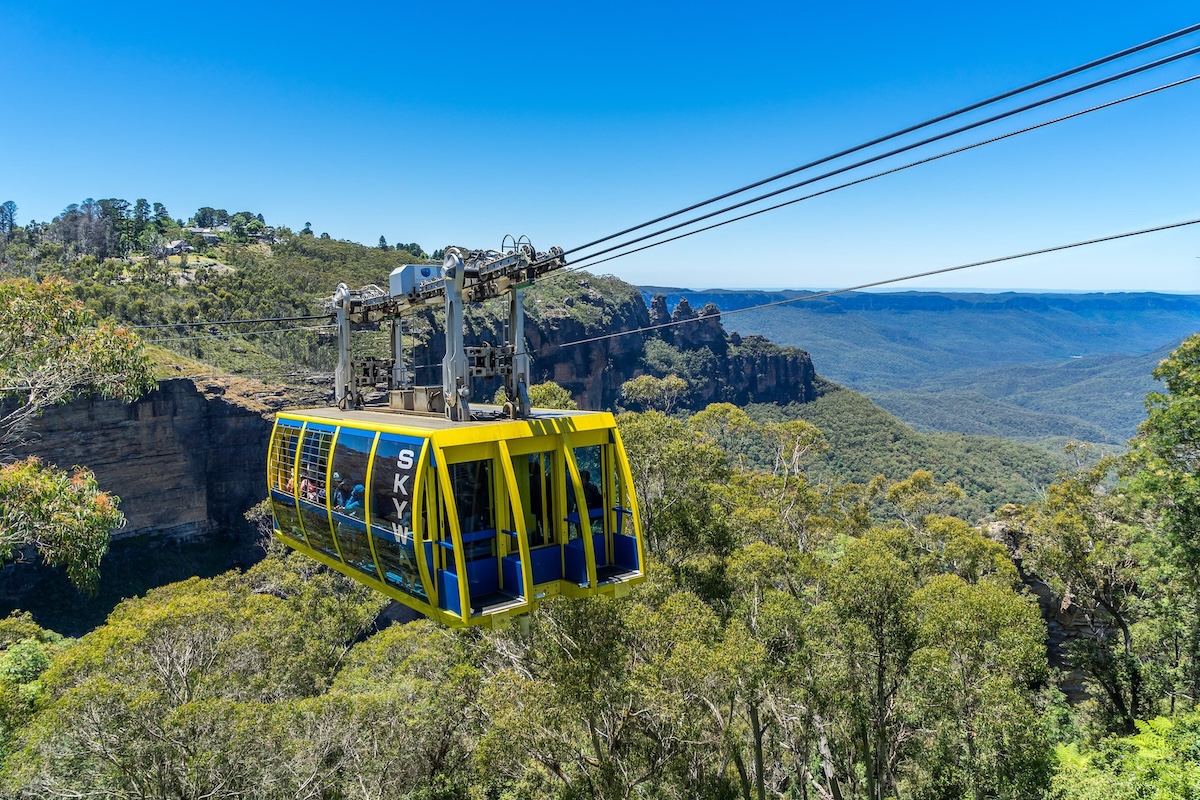
Opened in 1958, the Scenic Skyway was Australia's first cable car. A new Swiss-made cabin was launched in 2017, carrying 84 passengers every 10 minutes. It is now the largest aerial cable car in the Southern Hemisphere.
Best Cable Cars for Skiing
Though it’s no secret, the Chamonix Valley of France is undeniably the world’s best cable-car access skiing.
While there’s certainly an argument that Chamonix isn’t the best skiing in the world, it is number one when it comes to using cable cars to access ski terrain. The valley is littered with trams and gondolas, accessing diverse and incredible ski terrain. You hardly have to ride a chairlift here if you don’t want to.
Looking for wide-open bowls that hold cold snow? Check out the village of Argentiere. The Grands Montets has an incredibly efficient lift network of two aerial trams and two gondolas (plus a few chairlifts for good measure). Unfortunately, the mid-station connecting the two trams burned down in 2018, and the new system won’t be ready until at least 2025.
A brand new Charmillion Gondola accesses the beginner/intermediate terrain from the village of Le Tour.
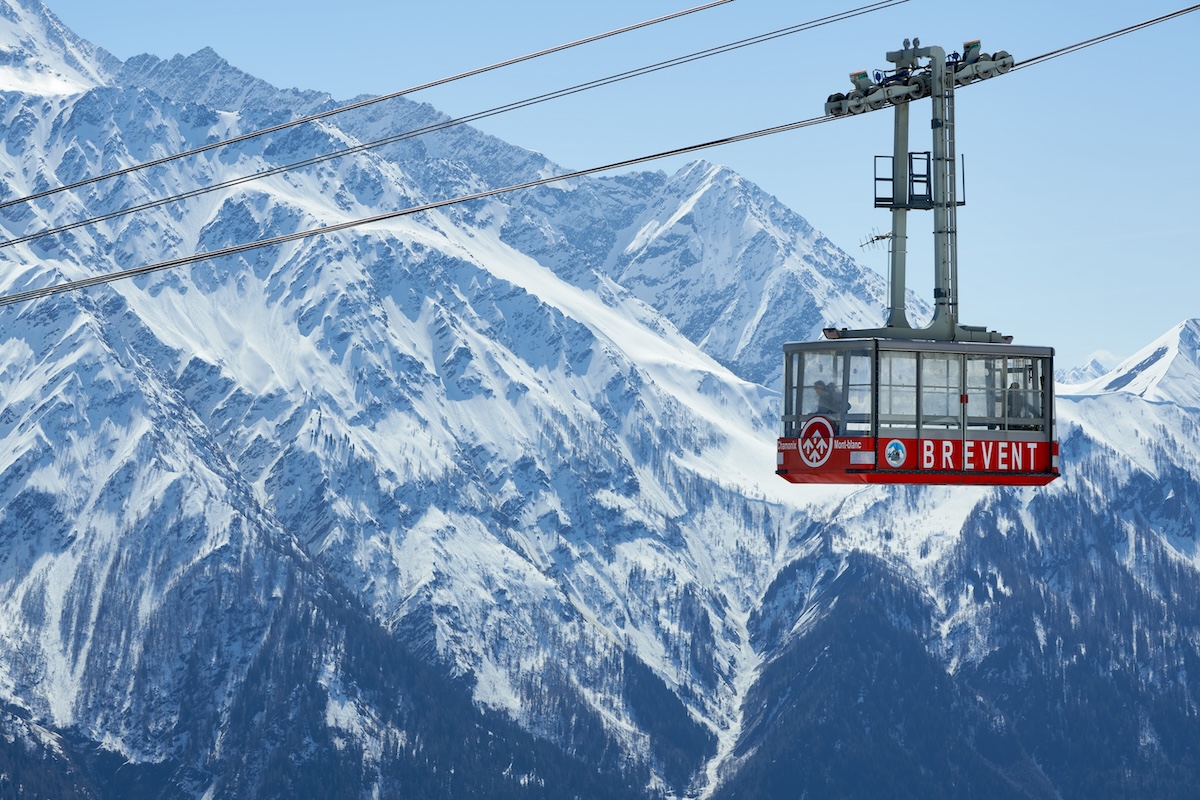
From the center of Chamonix, Brévent offers two tram rides. The first reaches the mid-mountain base, with access to plenty of open bowls amidst sunny, south-facing slopes. The second takes skiers to the ridgetop with excellent access to extreme ski descents.
Last but not least is the aforementioned Aiguille du Midi, taking skiers 2800 m (9200 ft) to the world's most extreme lift-access ski descents.
Additional Information
This article only mentions a couple dozen of the thousands of cable cars out there. If you’re not feeling satiated and need to consume even more information on these mountain taxis, I recommend consulting the Wikipedia article on Aerial Tramways. It’s one of the most comprehensive sources on the web for cable cars across the globe.

